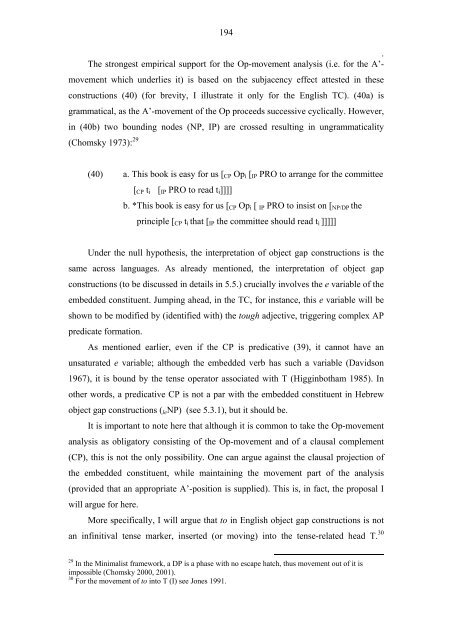The Category P Features, Projections, Interpretation
The Category P Features, Projections, Interpretation
The Category P Features, Projections, Interpretation
Create successful ePaper yourself
Turn your PDF publications into a flip-book with our unique Google optimized e-Paper software.
194<br />
.<br />
<strong>The</strong> strongest empirical support for the Op-movement analysis (i.e. for the A’-<br />
movement which underlies it) is based on the subjacency effect attested in these<br />
constructions (40) (for brevity, I illustrate it only for the English TC). (40a) is<br />
grammatical, as the A’-movement of the Op proceeds successive cyclically. However,<br />
in (40b) two bounding nodes (NP, IP) are crossed resulting in ungrammaticality<br />
(Chomsky 1973): 29<br />
(40) a. This book is easy for us [ CP Op i [ IP PRO to arrange for the committee<br />
[ CP t i [ IP PRO to read t i ]]]]<br />
b. *This book is easy for us [ CP Op i [ IP PRO to insist on [ NP/DP the<br />
principle [ CP t i that [ IP the committee should read t i ]]]]]<br />
Under the null hypothesis, the interpretation of object gap constructions is the<br />
same across languages. As already mentioned, the interpretation of object gap<br />
constructions (to be discussed in details in 5.5.) crucially involves the e variable of the<br />
embedded constituent. Jumping ahead, in the TC, for instance, this e variable will be<br />
shown to be modified by (identified with) the tough adjective, triggering complex AP<br />
predicate formation.<br />
As mentioned earlier, even if the CP is predicative (39), it cannot have an<br />
unsaturated e variable; although the embedded verb has such a variable (Davidson<br />
1967), it is bound by the tense operator associated with T (Higginbotham 1985). In<br />
other words, a predicative CP is not a par with the embedded constituent in Hebrew<br />
object gap constructions ( le NP) (see 5.3.1), but it should be.<br />
It is important to note here that although it is common to take the Op-movement<br />
analysis as obligatory consisting of the Op-movement and of a clausal complement<br />
(CP), this is not the only possibility. One can argue against the clausal projection of<br />
the embedded constituent, while maintaining the movement part of the analysis<br />
(provided that an appropriate A’-position is supplied). This is, in fact, the proposal I<br />
will argue for here.<br />
More specifically, I will argue that to in English object gap constructions is not<br />
an infinitival tense marker, inserted (or moving) into the tense-related head T. 30<br />
29 In the Minimalist framework, a DP is a phase with no escape hatch, thus movement out of it is<br />
impossible (Chomsky 2000, 2001).<br />
30 For the movement of to into T (I) see Jones 1991.
















